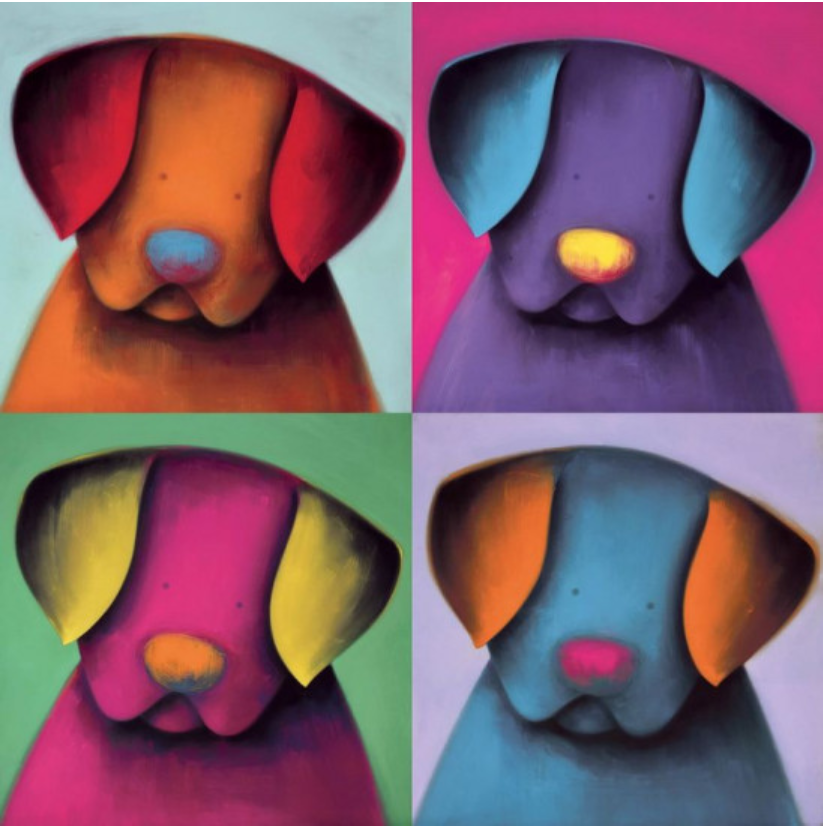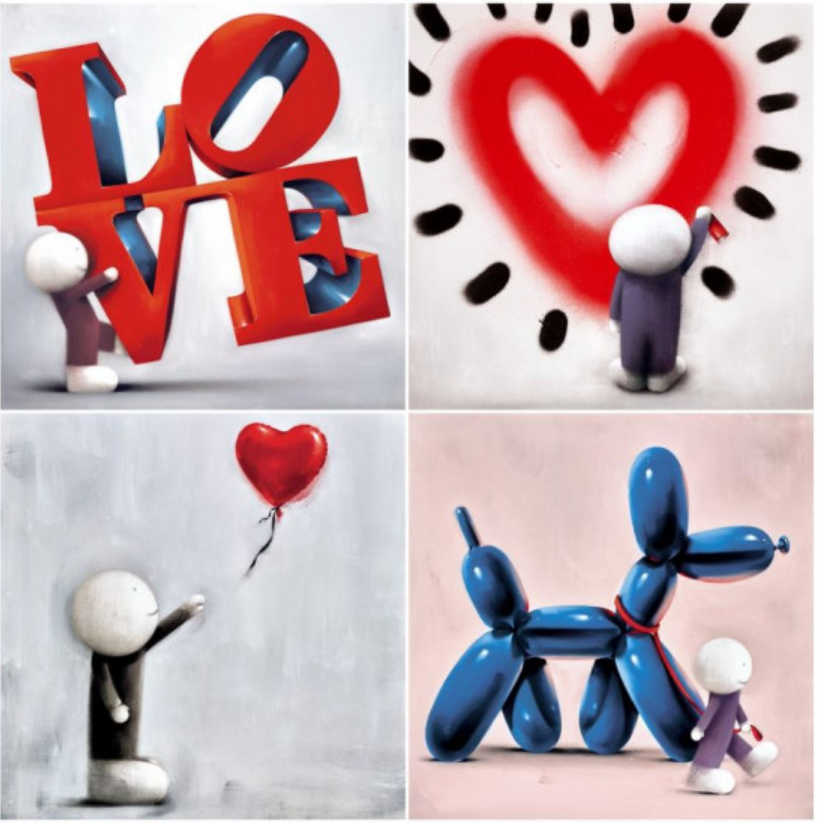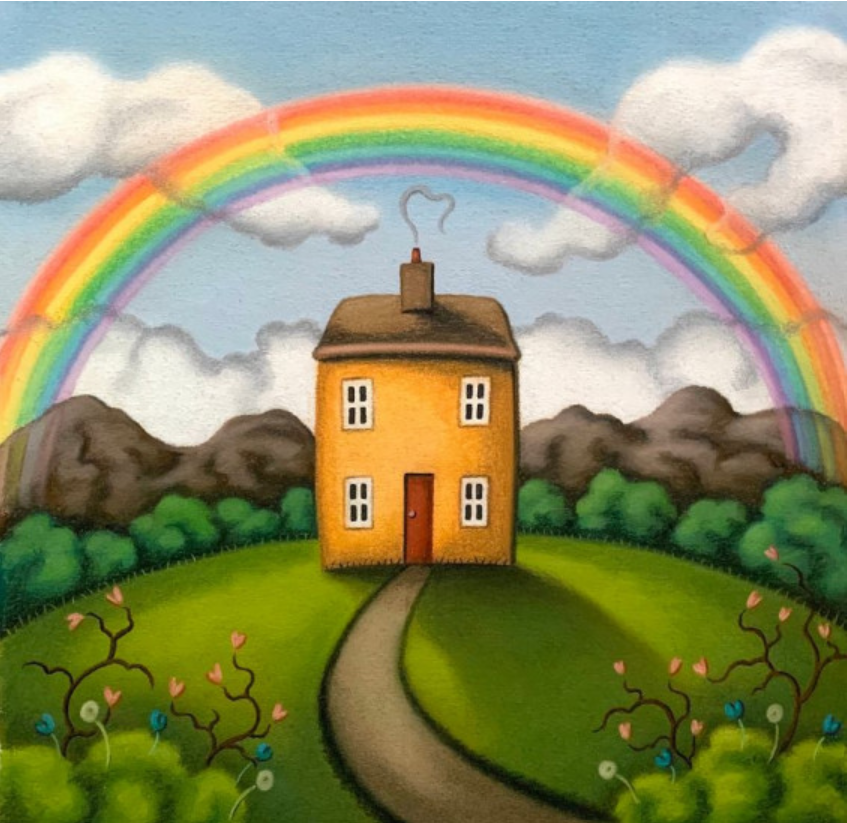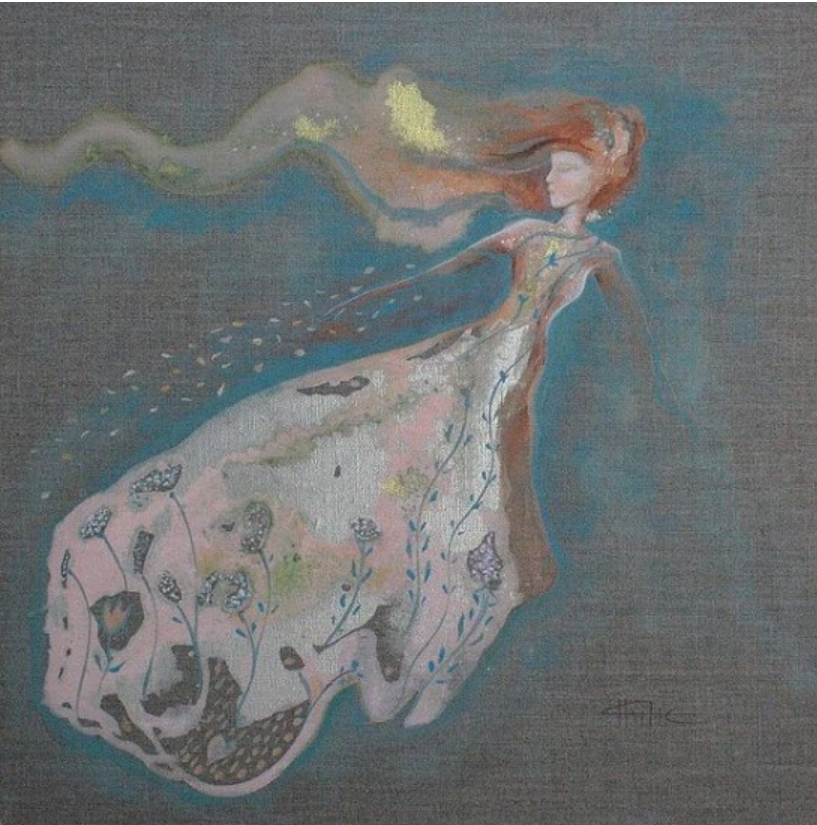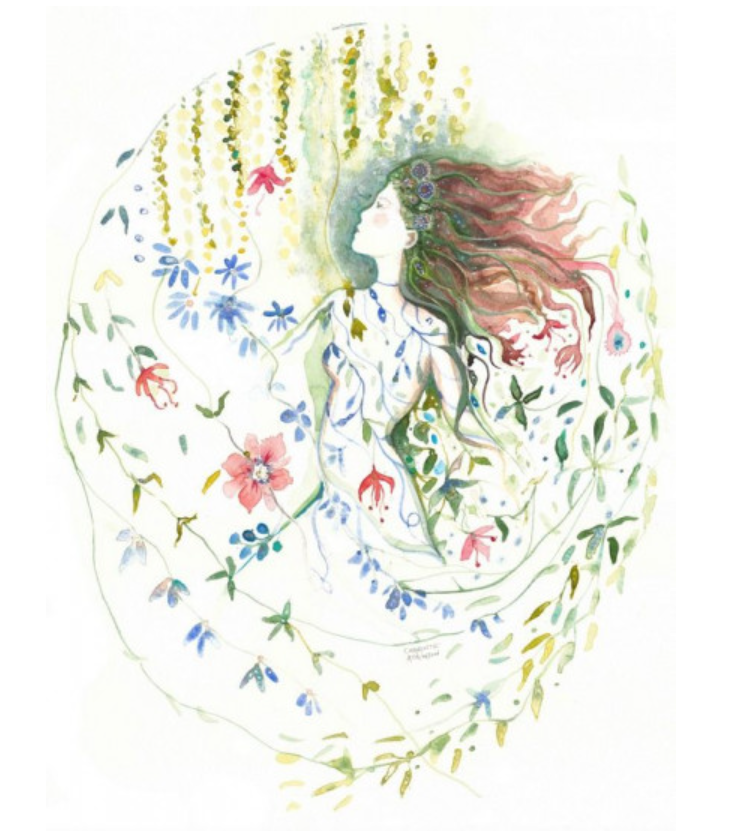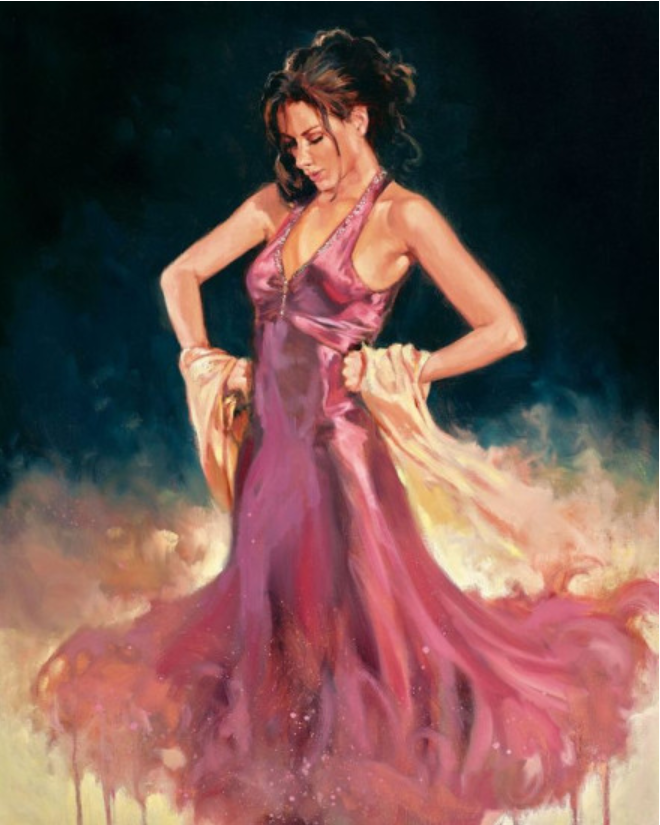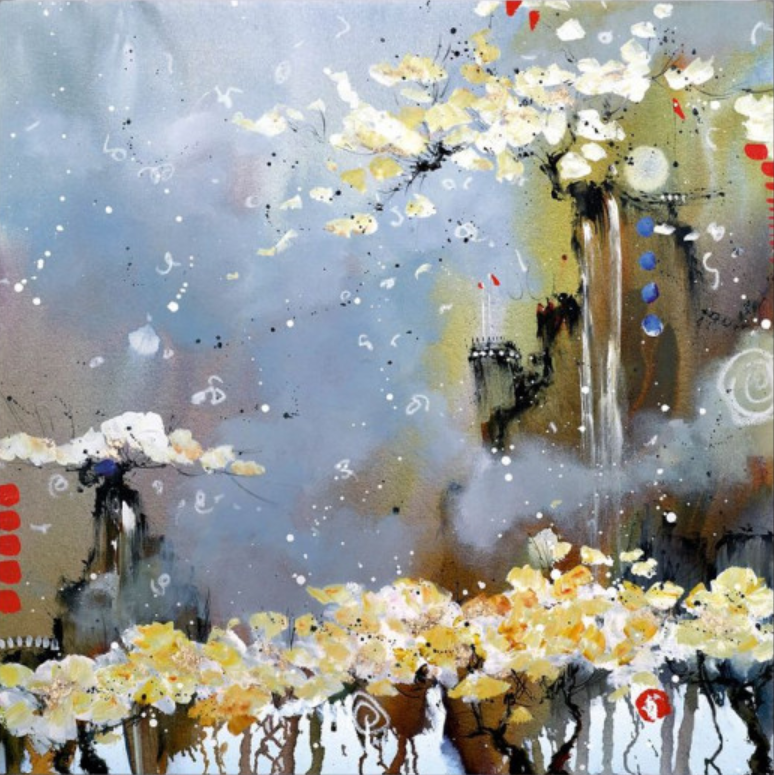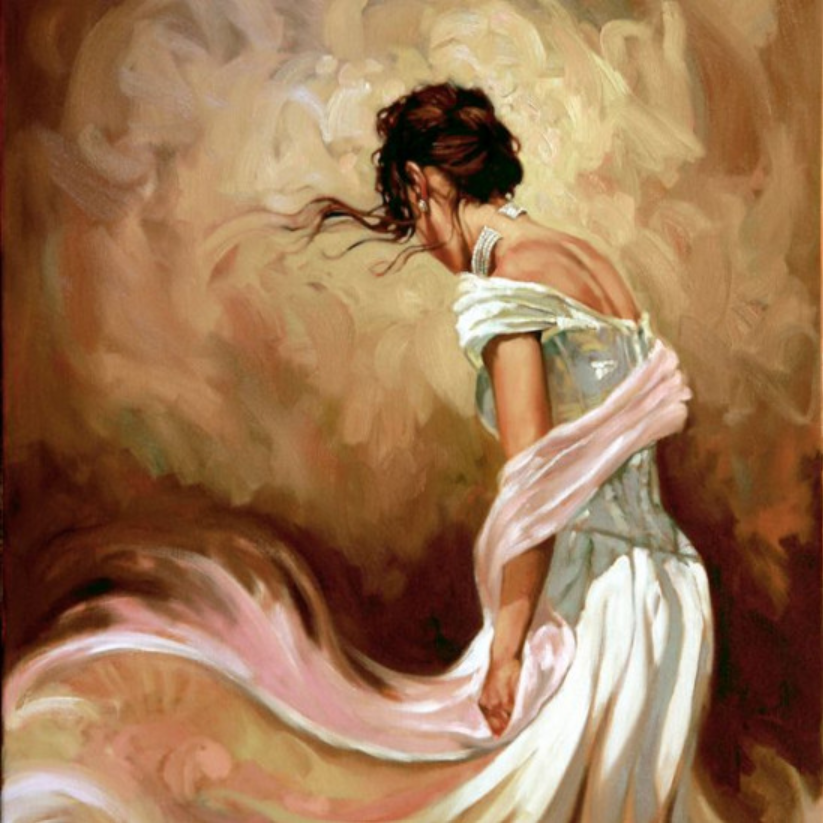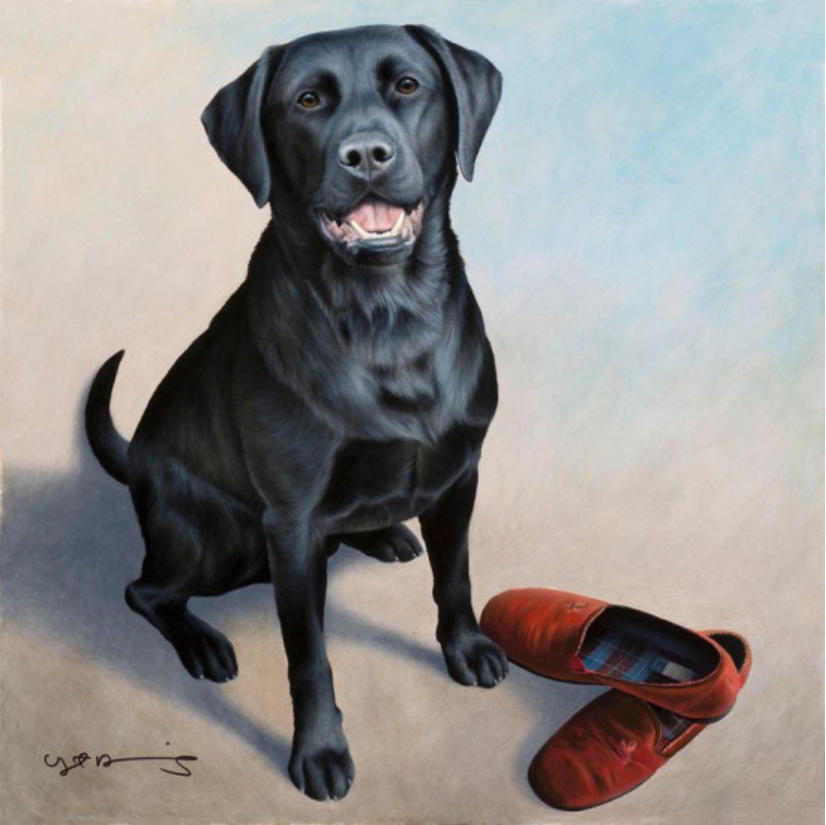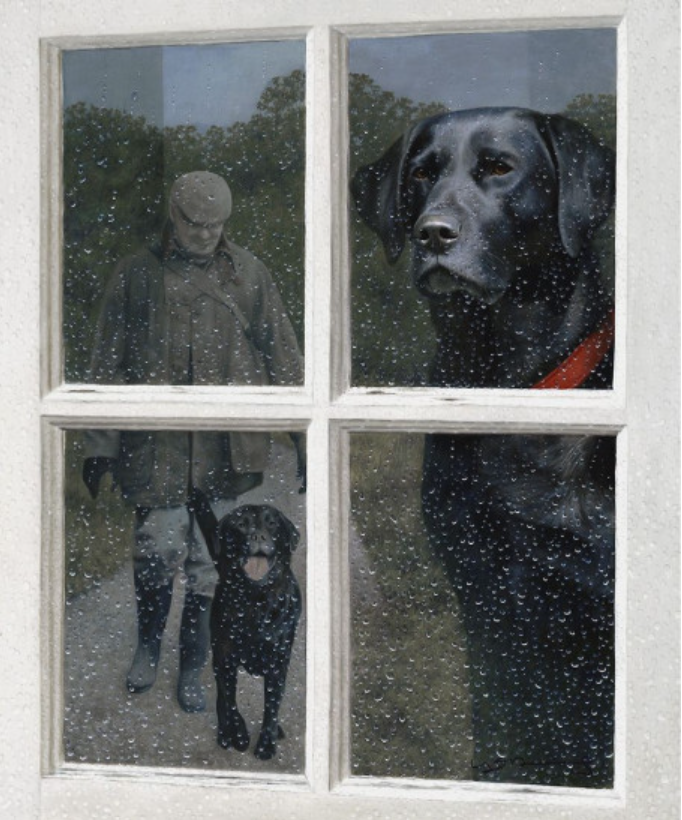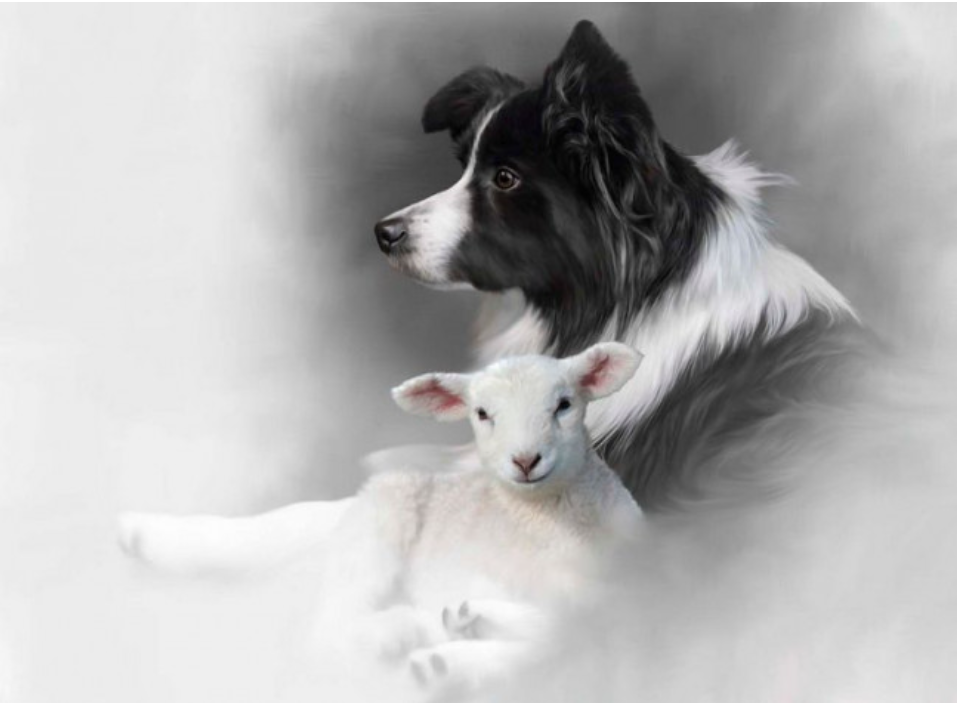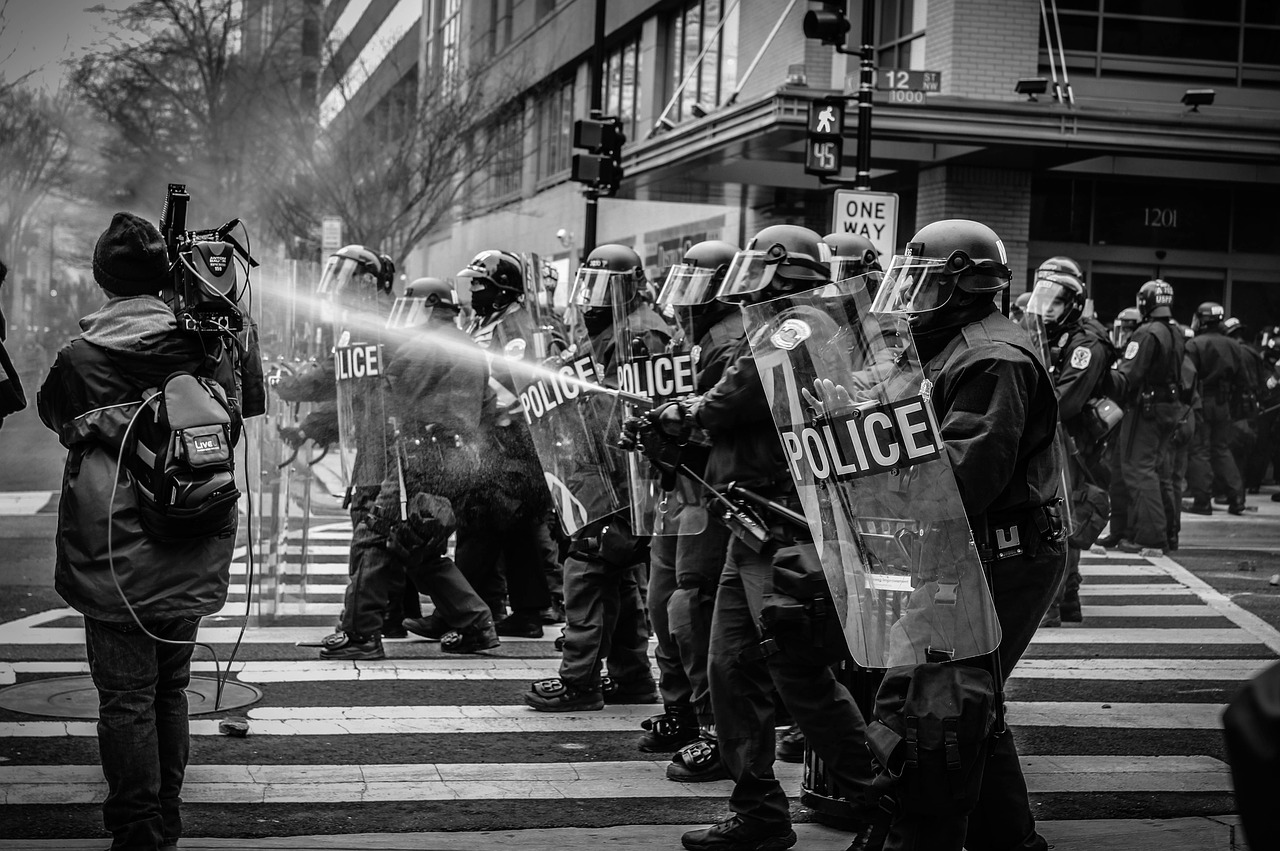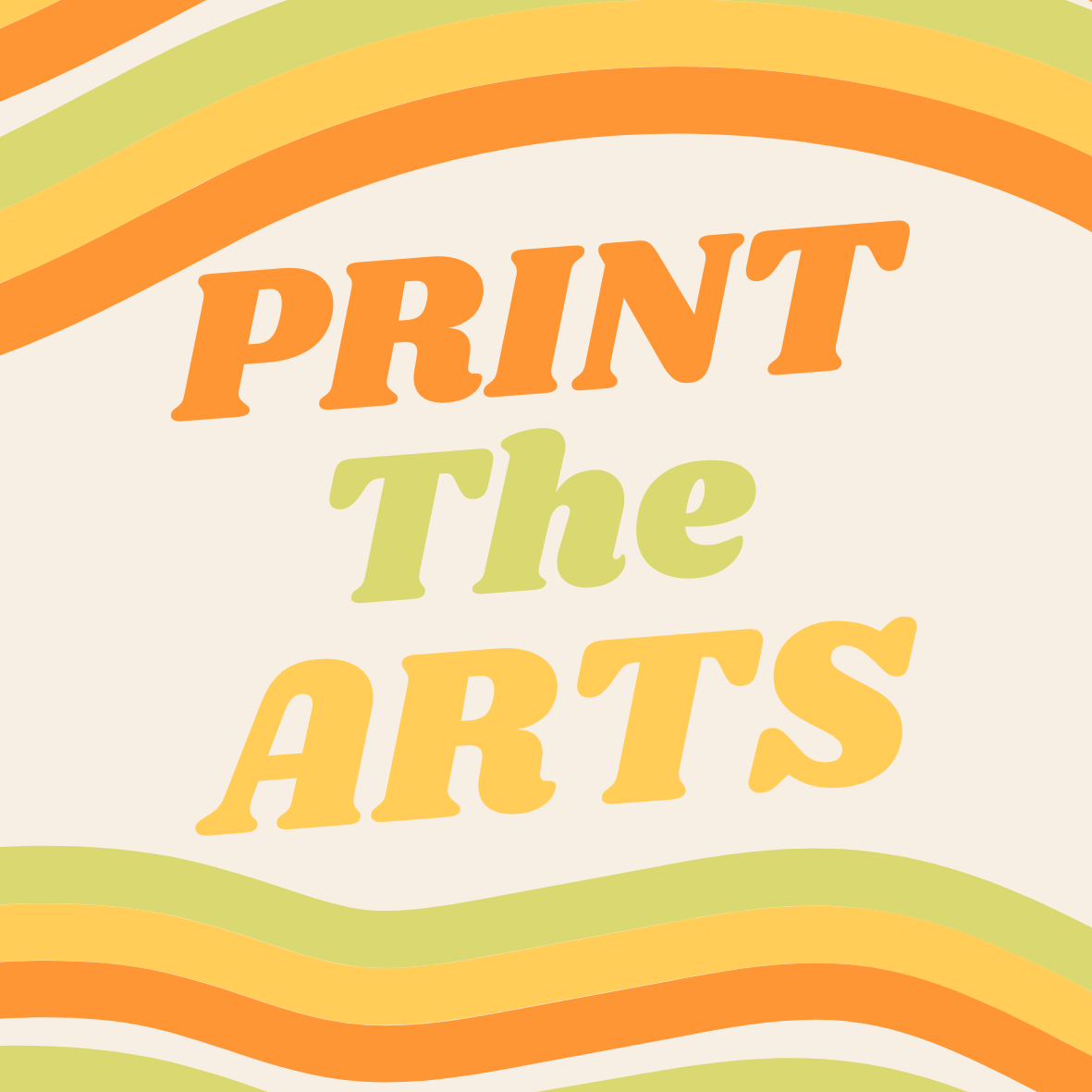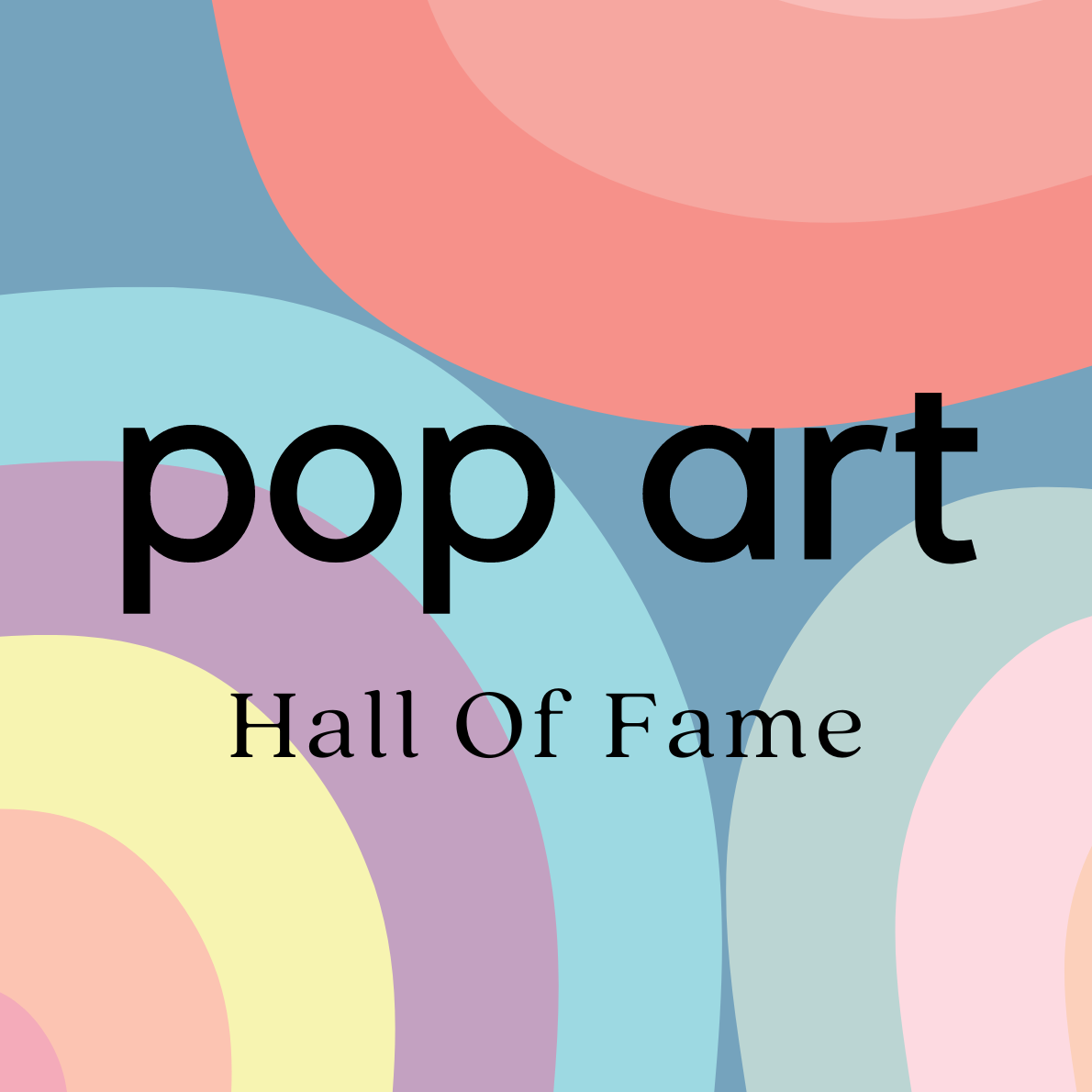In the late 1950s, a new art movement emerged in England that would eventually take the world by storm. This movement was called Pop art, and it was characterised by a unique blend of fine art and low culture.
Pop art brought together the worlds of high art and popular culture, seamlessly merging the two in a way that had never been done before.
Pop art was spearheaded by a group of trailblazers, including Richard Hamilton, Eduardo Paolozzi, and Peter Blake. These artists were drawn to the themes of youth culture, including rock and roll, television, movie stars, and comic books.
They also paid particular attention to the rise of consumerism after World War II, with an emphasis on the proliferation of home appliances and popular products.
As the movement gained momentum, it soon spread to New York, where it was embraced by artists such as Andy Warhol and Roy Lichtenstein. These artists continued to push the boundaries of what Pop art could be, creating some of the most iconic works of the movement.
Today, Pop art remains one of the most influential and enduring art movements of the modern era. Its impact can still be seen in contemporary art, as artists continue to be inspired by its unique blend of fine art and popular culture.
As we delve into the world of Pop art, it’s impossible to ignore the many prominent figures who helped shape and define this iconic movement.
Here, we take a closer look at 20 of the most influential figures in Pop art, from its early days in England to its rise in New York and beyond.
Richard Hamilton
Richard Hamilton (1922-2011) was an English artist and one of the leading figures in the mid-to-late 20th century British Pop Art movement.
He was a pioneer in the field of Pop Art, best known for his iconic collage ‘Just What Is It That Makes Today’s Homes So Different, So Appealing?’ which has become a symbol of the Pop Art movement.
Hamilton’s work was incredibly diverse, covering a wide range of media, including painting, photography, printmaking, and film. Although he was primarily known for his 2D work, he also experimented with installation, sculpture, and computer-generated images.
He was a prolific artist and his body of work remained consistently challenging, inventive, and influential throughout his career. Hamilton was heavily inspired by the Pop Art movement of the 1950s and 1960s, and he often incorporated mass-produced objects, advertisements, and consumer culture in his artwork.
He was also a great admirer of Marcel Duchamp, and many of his works pay homage to Duchamp’s ready-mades. As well as his own artwork, Hamilton was an influential teacher, mentor, and curator.
He taught at various art schools, including the Royal College of Art and the Slade School of Fine Art, and he curated several hugely successful exhibitions, including ‘This is Tomorrow’ in 1956, which is widely credited with launching the Pop Art movement in Britain.
Richard Hamilton’s contribution to the art world, and to the development of the Pop Art movement, is immeasurable. His work has been exhibited in galleries and museums around the world and his legacy continues to leave an indelible mark on the world of art.
Some of Richard Hamilton’s most famous works include:
1) Just What Is It That Makes Today’s Homes So Different, So Appealing? – Hamilton’s iconic collage of consumer culture and art, depicting a floating head of a man surrounded by consumer goods.
2) The Citizen – A large oil painting that examines consumer culture by focusing on a figure standing by a van filled with consumer items.
3) The Finishing Line – A painting showing a tightly packed, elongated procession of workers marching in circles while holding consumer products
4) Man, Machine and Motion – A painting that examines the human relationship to technology, portraying a man with his head placed inside of a machine.
5) The Exercise – A highly influential print depicting a rendition of the Trojan Horse in profile.
6) Project for a Small Signboard – A set of prints depicting cartoon-style figures near a signboard that reads “This Is Tomorrow” and “Better Prices Everyday”
7) Swingeing London 67 – A series of prints that examines the consequences of a police raid on the home of a radical artist
Pauline Boty
Pauline Boty was a British artist, model, and political activist who was a major figure in the British Pop Art movement of the 1960s.
She was the only female artist associated with the British Pop Art movement and was known for her vibrant and sexually charged paintings that challenged traditional gender roles and addressed political issues around the civil rights movement.
Born in 1938, Boty studied at the Wimbledon School of Art before moving to the Royal College of Art in London. At the RCA, she was one of the leading figures in the British Pop Art movement, alongside David Hockney and Peter Blake.
She explored the boundaries of painting and sculpture by using a wide range of materials, from oil paint to found objects. Boty was also a political activist and a vocal supporter of the civil rights movement in the United States.
She was an active member of the Campaign for Nuclear Disarmament and the Women’s Liberation Movement, and was often vocal about her support for women’s rights.
Boty’s art was often seen as controversial due to its sexual content and its confrontational approach to gender roles. Her most famous painting, The Only Blonde in the World, portrays a nude woman surrounded by a group of men and women in everyday clothing.
The painting was seen as a bold statement on the status of women in society. Boty died in 1966 at the age of 28, having produced a rich body of work that continues to inspire and challenge viewers today.
Her legacy as a pioneering and provocative artist lives on, and her work continues to be celebrated and discussed in the world of art and beyond.
Some of Pauline Boty’s most celebrated works include:
1) The Knack – A painting depicting a group of scantily clad women lounging against a red background.
2) Bikini with Butterflies – A collage featuring a bikini-clad woman surrounded by butterflies.
3) Double Nude – A painting featuring two female nudes, one in a pink dress and one in a blue dress.
4) Girl in a Swing – A painting depicting a woman in a red dress joyously swinging on a swing.
5) The American Girl – A series of paintings featuring a woman in a red dress, representing the American ideal of beauty.
6) Who’s Who in the Zoo? – A series of paintings featuring animals in human poses, reflecting on the nature of identity.
Eduardo Paolozzi
Eduardo Paolozzi is a Scottish sculptor and pop artist of Italian descent. He was born on March 7, 1924 in Leith, Edinburgh, and educated at the Edinburgh College of Art and the Slade School of Art in London.
Paolozzi is known as one of the influential pioneers of pop art, along with Richard Hamilton and Peter Blake, as he sought to introduce American influence into the British art scene.
Paolozzi’s early art career was marked by his interest in Surrealism, initially self-taught, but ultimately guided by the masters of the movement.
His works from this period are considered some of his most innovative, exploring the relationship between objects, space and the subconscious, incorporating aspects of industrial sculpture in the process.
His most iconic pieces from this period were produced through juxtaposing disparate and outdated objects, such as stuffed toys, as symbols of moral decay and technology, a homage to Dadaism.
Later, in the 1950s, Paolozzi was exposed to elements from American pop culture during his visits to New York, particularly comics, advertising and science fiction.
The strong imagery of this era and its cultural tropes heavily influence the collage and print works he crafted in the following years, fusing elements of natural, mechanical and the surreal to create bold works with a distinct aesthetic.
Paolozzi’s artwork not only reflected the culture and society of the time, but often served as commentaries on them. Through these pieces, he challenged societal norms, conventions and constructs, pushing against the established ways to explore deeper, more meaningful issues.
His later works, like the Large Heat-Treated Colossus and Machine As Seen in Shop Window, further illustrated these same themes, with the use of disjointed, abstracted bodies of machinery to suggest a loss of humanity.
To this day, the works of Eduardo Paolozzi remain a strong influence in the worlds of art, design and architecture.
His relationship with pop culture and his skillful incorporation of found objects, clashing forms and industrial sculptures has made him a pioneer of the movement and his legacy continues to live on in the works of contemporary artists across the globe.
Get to know these pieces below;
1) Small Scientist – A mixed-media collage that featured this fragmented, mechanised figure of a scientist set against a traditional still life background.
2) The Tragedy of Headlessness – This print featured a disjointed human head made of machine elements, to reflect a loss of humanity.
3) As Is When – A large-scale sculpture made of scrap metal and machine parts, a critique on the society’s dependence on industrial products.
4) Exploding Brain – A colourful and chaotic print that illustrated a melting pot of visual elements, taken from sources like comics and advertising, representing a fast-paced consumer-driven culture.
5) Large Heat-Treated Colossus – A multi-material sculpture featuring fragments of interconnected and fragmented machinery, representing both humanity and its lack thereof.
6) Machine As Seen In Shop Window – This scrap metal sculpture was created from leftover components from Paolozzi’s studio and combined together to form a machine-like figure.
Evelyne Axell
Evelyne Axell was an incredibly influential and pioneering Belgian artist who left a lasting mark on modern art.
An influential figure of the pop art movement, Axell is best known for her intense and bold Pop images, often displaying nudity and eroticism in a unique and provocative fashion.
Axell was born in Brussels in 1935 and left an indelible mark on the art world before her death in 1972. An accomplished painter and sculptor, she often combined the two to create her signature works.
She was an early pioneer of the pop art dub scene, and was known for her bold and colourful lines. Her works often featured contrasting colours, often drawing on popular comic books, advertising slogans and publicity materials in her artwork.
Her work was highly influential, often credited with playing a role in inspiring the Pop art movement in Belgium. Axell had a fiercely individualistic style, and wasn’t afraid to draw attention to sexuality, gender roles, and the shifting acceptance of these topics in society.
She was a keen observer of trends and behaviours, often incorporating them into her own works in her own unique way.
Axell has been credited as an early feminist artist, a pioneer who blew away conventions to create truly unique and inspiring works of art. To this day her influence is still felt in the art world, with many modern artists citing Axell as an inspiration for their own creative journey.
Evelyne Axell’s most famous works include:
1) Love Kiss – In this iconic work, Axell blended her signature pop art sensibilities with traditional oil painting techniques. It portrays a kiss between two young women, Artemesia and Eugenie, rendered in bold and contrasting colours.
2) The Redeemer – This sculpture captures an image of a woman lying slumped over in a crucifix shape. It was created in clay and plaster for an exhibition in London and it emphasised the artist’s increasing interest in death and mortality.
3) Pleasure – This work captures the essence of pleasure in a bold and provocative manner. It features a female figure in a swimming pool and, through its bold colours and shapes, Axell gives us a snapshot of her own troubled life.
4) Joy and Anguish – This oil painting was created shortly before the artist’s death and captures a sense of emotional turmoil. It portrays two figures – one male and one female – who appear to be in emotional distress, with a grey and blue colour palette conveying a feeling of distress and tragedy.
Peter Blake
Sir Peter Blake is a British pop artist who first came to fame in the 1960s. He is best known for his popular culture collages and works featuring celebrities, which often draw on aspects of British folk culture.
His most iconic images include the cover of the Beatles’ 1967 album Sgt. Pepper’s Lonely Hearts Club Band, a piece known as “The Godfathers of Pop”, and several images from his own series on people in British life, “People in My Life”.
Blake was born in Dartford, Kent in 1932. After serving in the Royal Navy for two years, he attended the Royal College of Art in London. He studied painting and silkscreen printing, both of which he drew on heavily in his work.
His early work was primarily traditional figurative pieces, though he eventually moved into more abstract constructions.
His first success came when his pieces were featured in the landmark exhibition “Young Contemporaries”, alongside works by David Hockney and other emerging pop artists.
Throughout his career, Blake has used a range of media to express his interests. These include painting, drawing, silkscreen printing, and photography. He often works in collage, exploiting the juxtaposition of different materials to create his signature pieces.
For example, his painting “6 Times 6” (1974) is a collage of vintage newspaper photographs, magazines, film stills, and musical instruments. His distinctive photo-realistic style is highly recognisable and influential.
Peter Blake has exhibited his work worldwide over the past six decades and has consistently been recognised for his innovation and bold artistic vision.
He was awarded a CBE in 1981 for his services to art and was nominated for a Nobel Prize in Literature in 2004. He has similarly been knighted for his enduring impact on the world of visual culture.
His work is included in numerous public collections around the world and his legacy will remain, inspiring generations of creators to come. Let’s have a look…
1) The Godfathers of Pop – Blake’s first major work, a detailed collage made up of images depicting pioneering British rock and roll stars, including Elvis Presley, Cliff Richard, and The Beatles.
2) 6 Times 6 – A painting made up of a collage of vintage newspaper photographs, magazines, film stills, and musical instruments.
3) The Battle of Britain – A series of 17 prints depicting Battle of Britain fighter planes and pilots.
4) Homage to Newton – A photographic work collaging together images of Newton’s principles of the laws of nature with everyday objects and people.
5) The Disasters of War – A series of photomontages commenting on the destructiveness of modern war.
6) Sgt. Pepper’s Lonely Hearts Club Band – an iconic cover of the Beatles’ album, widely considered the first real example of a ‘Pop Art’ cover.
7) Work in Progress – An assemblage made up of magazine images of famous figures, including the Queen and Marilyn Monroe.
8) People in My Life – A series of prints which capture ordinary people’s lives in witty, vibrancy, and vivid colour.
Yayoi Kusama
Yayoi Kusama is one of the most influential Japanese artists of the contemporary era, working in an impressive range of media and earning a global reputation for her avant-garde aesthetics and three-dimensional creations.
Born in Matsumoto, Japan in 1929, Kusama went on to study Nihonga, a traditional Japanese painting style, at Kyoto Municipal School of Arts and Crafts.
By the 1950s, she had moved to New York where her unique style of art, characterised by bright bold colours, organic formations and playful repetition, began to captivate the art world.
Today, Kusama is renowned for her interactive installations, sculptures and paintings that explore themes of femininity, the cosmos and psychology. She is particularly renowned for her Infinity Mirror Rooms, which feature halls of kaleidoscopically coloured mirror walls, created with an intricate system of optical illusions.
Kusama has also produced a great body of work in the form of paintings, drawings, soft sculptures, poetry and performance art. Her work often references recurring motifs such as spotted pumpkins, infinity nets and soft sculptures of painted stuffed fabric.
Kusama’s work is internationally recognised, with works being held in major modern and contemporary art museums, including the Museum of Modern Art and the Whitney Museum of American Art in New York.
Over the years, her exhibited works have become the subject of feature films, notable public art projects and global travelling exhibitions.
Most recently, Yayoi Kusama has earned global recognition for her ‘Dots Obsession – Infinity Mirrored Room – Filled with the Brilliance of Life’ installation, which travelled through Tokyo and Seoul to arrive at its permanent residence in New York City’s South Street Seaport.
Some of Yayoi Kusama’s most famous works include:
1) Infinity Nets – Infinity Nets are a series of abstract and lyrical paintings depicting fields of intertwining loops of muted colours. They are often seen as an expression of chaos and infinity, and have become a major motif in Kusama’s work.
2) Soft Sculptures – Soft Sculptures are a series of visual and tactile fabric sculptures featuring patterns of Kusama’s signature spotted pumpkins, nets, or eyes. A distinct feature of these sculptures is the use of felt and other soft materials, which Kusama often uses to comment on the human body.
3) Infinity Mirrored Rooms – Infinity Mirrored Rooms are a series of installation works, which use infinity and mirrored surfaces to create an immersive installation experience. These works often explore the nature of infinity and dynamism of time, and feature bright and diverse colour palettes.
4) Narcissus Garden – Narcissus Garden is an ongoing participatory installation/performance artwork by Kusama that features vast fields of stainless steel spheres. It is seen as a comment on consumerism, and explores themes of mass-production and repetition.
5) Pumpkin Series – The Pumpkin Series is a recurring motif in Kusama’s paintings, sculptures and installations. It often features plant-like spotted silhouettes in bright and vibrant colours, and explores themes of proliferation and infinity.
Andy Warhol
Andy Warhol was an iconic American artist and one of the most influential figures in the Pop Art movement of the 1960s.
Born on August 6th, 1928 in Pittsburgh, Pennsylvania to immigrant parents, he attended the Carnegie Institute of Technology to study art.
Following early success selling drawings to magazines and free-lance illustrating, Warhol’s belief that “good business is the best art” quickly gained him renown and he went on to become one of the most famous and iconic artists of the 20th century.
Warhol’s use of popular imagery and consumerist themes in his work helped to redefine fine art and introduced a revolutionary approach to the concept of originality.
His extensive body of work spans a wide range of media, from painting and photography to film, sculpture, and graphic design.
Warhol also had a reputation for being an eccentric and charismatic personality who rubbed shoulders with the rich and famous.
Perhaps most famously, Warhol is known for his series of silkscreen prints of brightly-coloured images depicting celebrities like Marilyn Monroe and Mao Zedong.
He also popularised the use of repetition and iconic imagery, most notably evidenced in the “Marilyn Diptych” in which he used the same image of Monroe’s face in a variety of colours.
He famously said that “In the future everyone will be world-famous for fifteen minutes,” encapsulating his belief that celebrity culture was taking over the art world.
Warhol died in 1987 but his influence continues to reverberate throughout the art world today, some pieces you need to get to know are…
1) Campbell’s Soup Cans – This series of prints was composed of 32 canvases, each depicting a different flavour of Campbell’s Soup. The series critiqued the brand’s powerful hold on U.S. culture and instantly became one of Warhol’s most iconic works.
2) The Marilyn Diptych – This piece was a combination of silkscreen and hand-painted images of Marilyn Monroe paired with bold colours and patterns. It is considered to be one of Warhol’s most iconic works.
3) Electric Chair – Depicting the electric chair used in the execution of death row inmates at Sing Sing Prison. He aimed to make people reflect on the death penalty, a controversial topic in the U.S. at the time.
4) Cowboys and Indians – This print series depicted a showdown between two classic Wild West archetypes. The combination of bright colours and shapes gives it a modern, abstract feel.
5) Banana – Released as a single print, this work is a combination of a photograph of a banana and overprinted text. It became Warhol’s most iconic Pop Art piece.
Rosalyn Drexler
Rosalyn Drexler (b. 1926) is an American artist, novelist and playwright who has had a substantial influence on the art world for over five decades.
She has had a long and varied career, beginning as a freelance illustrator in the 1950s, and evolving into a prominent Pop artist during the late 1960s and early 1970s.
Her Pop art often featured references to popular culture, including comic strips and movie posters, and was marked by an irreverent humour and a vibrant, overwhelming colour palette.
In more recent years, Drexler has turned to painting, producing large-scale pieces that incorporate detailed hand-drawing with elements of Pop art and street art.
She has also become increasingly political in her work, producing pieces that address the plight of refugees and those affected by war and political violence.
Even as her art has evolved, Drexler has maintained a unique style, characterised by boldness and a refusal to adhere to conventions.
She is widely credited for bringing a distinct and eclectic voice to the Pop Art movement, paving the way for contemporary artists to express themselves without conforming to standard aesthetic norms.
A native of New York City, Drexler has received numerous awards and accolades for her work, including three honorary doctorates from the School of Visual Arts, Parsons School of Design, and the Moore College of Art, as well as a MacArthur “Genius” Grant in 1984.
Her work can be found in numerous public collections, including The Whitney Museum of American Art, The Museum of Modern Art, The Hirshhorn Museum and Sculpture Garden, and The Museum of Contemporary Art in Los Angeles.
Among the best pieces to check out are here;
1) Superheros – This painting features superheroes from the comic books of Drexler’s youth, rendered in a dynamic and vibrant style.
2) Double Elvis – This vibrant painting depicts Elvis Presley in the iconic pose of jazz pianist Arthur Prysock.
3) God, Help Me – Don’t Worry – This large painting is set against a bright yellow background and features a crowded cityscape, in which a single figure is seen tending to a broken-down car.
4) War is Swell – This painting features a yellowed newspaper photo of a soldier surrounded by lurid, cartoon-like figures.
5) Sleepy Leon – This large painting features a character with a peanut-shaped head, who appears to be sleeping on a park bench.
6) I Will Not Conform! – This painting features a girl with wild hair, standing defiantly amid a background of brightly colored symbols and abstract figures. –
7) War Paint – This oil painting illustrates a character that is half woman, half machine.
8) If a Tree Falls in the Forest – This large-scale painting is painted in muted colours and features a tree surrounded by dark figures.
9) Defiant Woman – Painted in a swirling mix of colours, this painting depicts a woman standing defiantly in a stormy landscape.
Roy Lichtenstein
Roy Lichtenstein is considered to be one of the most influential and iconic American artists of the 20th century.
An important part of the Pop Art movement, Lichtenstein is renowned for borrowing images from popular culture, such as comic books, advertisements, and print media, to construct his paintings and sculptures.
Fascinated with both semi-mechanisation and mass production, Lichtenstein used these factors in his works to explore themes of identity and consumerism in America.
Lichtenstein began his artistic career as a freelance commercial illustrator in the late 1940s. In the 1950s, he moved away from his traditional illustrative style and towards a more abstract aesthetic, incorporating pieces of paper into his collage-style works.
In the late 1950s, Lichtenstein began experimenting with drawing cartoons and comics into his work, which ultimately transitioned him into the realm of Pop Art.
During the 1960s, as an integral member of the European and American Pop Art movement, Lichtenstein’s stylized works gained widespread recognition for their unique fusion of high art and popular culture.
This aesthetic was distinctive in its use of the Benday dots texture, crisp outlines and bright colours, which all helped to make his works universally recognisable.
The subject matter of Lichtenstein’s artwork often examined themes of romance, military, and consumerism.
His works were filled with visual references to the decadence and glamour of the modern consumer experience, and he frequently included simple, everyday objects in his works.
Lichtenstein was also heavily inspired by a variety of cultural influences such as Dadaism, Surrealism, Abstract Expressionism and his own traditional American roots.
All of these influences combined to create art that reflected the rise of consumer culture and media-driven society of the period.
Throughout his career, Lichtenstein achieved immense success in the art world, creating over 4,000 works of art between 1948 to his death in 1997.
His artwork can be found globally in major museums and galleries, which includes the Museum of Modern Art and the Guggenheim in New York, the Tate Modern in London and the Art Institute of Chicago.
Some of the finest pieces to get to know are;
1) Whaam! – This painting is famous for suggesting the effects of consumerism by depicting a fighter plane and an exploding enemy being shot down. The image was taken from a comic book panel and is thought to be a literal example of the ‘culture of the moment’ at the time.
2) Drowning Girl – This painting is considered one of Lichtenstein’s best works and is an example of his use of unconventional images to evoke emotions and moods. Here, he uses an image of a woman facing a watery death to comment on the fragility of life and the desperate situations faced by lovers.
3) Hopeless – This painting features a woman faced with a desperate situation, staring into the viewer in a state of resignation. Lichtenstein often used images from comic books in his works to examine the emotions of romantic relationships and to express the anguish of unrequited love.
4) Naked Man Descending a Staircase – This painting is an homage to Marcel Duchamp’s painting of the same name and is thought to be an example of Lichtenstein’s exploration of surrealism. This painting is filled with abstract imagery and hints at the idea of continuous movement and progress.
5) Oh, Jeff… I Love You, Too… But… – This well-loved painting is another example of Lichtenstein’s exploration of romance. Like many of his other works, it makes reference to a comic book panel in order to depict the fragile state of love between two people.
Marjorie Strider
Marjorie Strider (1939-2014) was a pioneering American artist who was internationally recognised for her complex depictions of women.
She began her career as a textile designer, but went on to experiment with a variety of media, including multiple platforms of painting, sculpture and printmaking. Her works drew primarily from psychological symbolism and surreal expressiveness, often featuring the female figure in dream-like scenes.
Strider held her first solo show in 1964 at the Cheim & Read Gallery in New York City. Later, she was included in prominent non-profit museum exhibitions such as the Brooklyn Museum’s “1974 Masterworks of Contemporary American Art”, the San Francisco Museum of Modern Art’s “Women Artists 1970-1980” and the Museum of Contemporary Art’s “The Human Presence: 75 American Figure Painters”.
Throughout her prolific career, Strider’s works illuminated the experiences of women, often referencing her own experiences of trauma, catharsis and spiritual awakening.
Through a diverse range of materials, such as wax and plaster, she explored psychological states as manifested in her own physical body. Strider was a long-time participant of the California arts scene and was affiliated with the Women’s Building collective in Los Angeles.
She was heavily influenced by the feminist avant-garde art movement of the 1960s, and was both a mentor and muse to many female artists.
Marjorie Strider’s works are included in numerous important collections, including the Los Angeles County Museum of Art, the Brooklyn Museum, and the Museum of Contemporary Art in Los Angeles.
With a career spanning more than five decades, Strider’s influence is still seen in the works of many contemporary female artists.
Some of her most influential artworks include;
1) String Portrait – String Portrait is a unique painting that, as the title suggests, incorporates strings into the work, incorporating repetitive lines across the female figure.
2) Head of Woman – This large-scale painting is an abstract and powerful representation of femininity, composed of broad strokes and geometric lines.
3) The Man Who Gave the Woman to the Sea – This monumental assemblage sculpture is a striking expression of inner and outer struggle. Made up of various materials, including wax and fabric, the sculpture speaks to our common struggles as humans.
4) After the Rain – This prized drawing conveys a sense of Surrealism and mystery, as the female is imagined in a post-apocalyptic world. The piece features bold yet delicate lines, creating an ethereal atmosphere.
5) Dancer in White – A stark white oil painting, this work depicts a woman in a ballet pose, reflecting on themes of movement and femininity.
Claes Oldenburg
Claes Oldenburg is a prominent American artist best known for his large-scale Pop Art installations.
His sculptures are often humorous and playful, taking mundane objects from everyday life and transforming them into larger than life sized replicas.
His iconic works involve transforming everyday objects into sculptures, such as a giant flashlight, corncob and clothespin. These pieces are often displayed in public spaces, bringing the artist’s work to a wider audience.
Born in Stockholm, Sweden in 1929, Oldenburg moved to New York City with his family in 1936.
He first studied painting at the Art Institute of Chicago, before transferring to Yale University, where he eventually earned a Fulbright Scholarship to study abroad in Paris.
After two years, Oldenburg returned to New York and developed a distinct style based on pop culture and consumer objects.
In 1961, he held his first solo show, which consisted of soft sculptures placed directly on the floor. It is this body of work that he is most known for today.
In 1965, Oldenburg began creating his large-scale Pop Art installations. He employed a wide range of materials and techniques, from rubber and plaster to fabric and vinyl.
He often collaborated with architects and engineers to ensure the structural stability of his works. His art strives to make viewers look at familiar objects in a new light; he was a social critic who sought to challenge accepted notions about modern art and society.
Oldenburg’s work has been depicted in numerous exhibitions, both in the US and internationally.
He has also received numerous honours and awards including the National Medal of Arts, and his art can be found in many major collections around the world.
Some of Claes Oldenburg’s most famous works include:
1) Lipstick (Ascending) on Caterpillar Tracks – A sculpture of a giant lipstick with caterpillar tracks on a base, which was displayed in various locations around the world, including the Albright-Knox Art Gallery.
2) Clothespin – A 37-foot stainless steel sculpture, created for Philadelphia’s Center City Square.
3) The Free Stamp – Is a twenty-four foot tall rubber and steel sculpture created for the people of Cleveland, Ohio.
4) Giant Figures Uprising – Is a series of large-scale public sculptures, including a polystyrene and aluminium refrigerator, and a 20-foot tall cotton candy maypole.
5) Store – This collection of sculptures created for an installation which included a life-sized replica of an ordinary store.
6) Flashlight – Is a polyester-resin and fibreglass sculpture, installed at the Hirshhorn Museum and Sculpture Garden.
Marisol Escobar
Marisol Escobar, a Venezuelan-born American artist, was a pioneer in many mediums including sculpture, painting, performance, and drawing.
Throughout her career, she explored the influence of gender, politics, culture, and identity on individualism and feminism.
In her works, Marisol often used everyday materials such as papier-mâché, wood, and terracotta to make her sculptures. Her sculptures often depicted human figures that depicted everyday people in a simplistic, stylised fashion.
Marisol’s style was influenced by both a deep understanding of art history along with a respect for traditional practices in sociology and anthropology.
Marisol is most famous for her 1972 sculpture, “The Family”, which is a group of nine life-size wooden figures.
This work was influenced by her own family experiences, as well as her desire to explore the connection between individual identity and community.
Her works often focus on depicting individuals and their relationship with the environment around them.
Marisol Escobar’s works have been exhibited all over the world in prestigious art museums such as the Metropolitan Museum of Art in New York, the Art Institute of Chicago, and the National Gallery of Art in Washington, DC.
Her works remain highly sought after as they explore themes that are both timeless and important, making them a vital part of our cultural heritage.
Some of the best Marisol Escobar pieces include:
1) The Family – This sculpture is composed of nine life-size wooden figures, and was inspired by Marisol’s family experiences, as well as her exploration of the relationship between individual identity and community.
2) Portrait of Eva Hesse – This sculpture is a tribute to avante garde artist Eva Hesse and features wood figures, shells and metal wire.
3) Evening – This sculpture is composed of carved wood and metal, and depicts a man and a woman walking together in evening dress.
4) Truck – This sculpture is composed of three metal figures riding in a floating truck and symbolises the journey life takes us on.
5) Four Women – This sculpture is composed of four metal and wood figures. It is a commentary on femininity, with the figures representing different stages in a woman’s life.
6) Professor Starbottle – This sculpture is composed of papier-mâché, wood and metal and was commissioned by a law school. It is a tribute to the role of the law in society and to the figures that have served in that field.
Keith Haring
Keith Haring was an American artist and social activist who rose to fame during the 1980s.
He was famous for his instantly recognisable graffiti-inspired art, often featuring figures with loose line work and contrasting bright colours.
He had an open and accessible visual language, and was dedicated to making his work available to all. Haring’s work focused on themes of social awareness, protest, and celebration.
He often used his art to comment on such issues as AIDS, racial inequality, and corporate greed, as well as questioning social structures and traditional values. His art was often influenced by his strong beliefs in underground cultures, queer culture, guerrilla art and anti-establishment thinking.
Haring was an early adopter of the Pop Art movement and was heavily inspired by iconoclastic figures such as Billie Holiday and Jean-Michel Basquiat. He often incorporated popular cultures and symbols into his work, such as the Radiant Baby which became his signature motif.
In addition to his artwork, Haring was a passionate advocate for AIDS awareness and activism. He was a founding member of the AIDS group ACT-UP (AIDS Coalition to Unleash Power) and often used his art and his public platform to put a spotlight on the on-going issues surrounding HIV/AIDS.
Haring’s dedication to activism and creating art for the people saw him become a public figure of immense popularity.
His artwork can be seen in galleries around the world, and continues to inspire a generation of artists today. He is celebrated for his unique style and for blurring the line between “high-art” and the everyday.
Some of the most influential are…
1) The Crack is Wack Mural – This iconic mural is located in East Harlem, New York. It depicts a giant ‘crack is wack’ statement with dancing figures alongside, and is an example of Haring using his fame to bring awareness to social issues.
2) ZooStation – This mural, painted in the Berlin subway, is an early example of Haring’s playful, street art-influenced style. It features a double-sided figure being pulled by two apes, and is a commentary on the apartheid regime of South Africa.
3) The Ten Commandments – This is a series of ten bronze doors, each one featuring one of the biblical Ten Commandments. It was created for the Church of St. Stefano in Rotterdam, the Netherlands.
4) Silence Equals Death – This poster was created to raise awareness of the growing AIDS crisis and was inspired by Haring’s involvement with ACT UP. It features the powerful slogan “Silence Equals Death,” along with a glowing red triangle.
5) Dog – This iconic painting was featured on the cover of Haring’s debut solo exhibition at the Church Street Annex in New York City. The painting features a stylized dog with a tongue sticking out and is representative of Haring’s playful and accessible style.
Idelle Weber
Idelle Weber (born 1936) is a contemporary American artist, best known for her innovative mixed-media work with collage, painting, and objects.
Her work is thought-provoking and offers a unique vision and commentary on the human condition. Weber’s work often deals with themes of identity, gender roles, and re-examination of past artistic forms.
She has continuously experimented with her art, toyed with the media and pushed the boundaries of what is accepted. She has been associated with the Feminist Art Movement of the 1970s, for her frank interpretations of the female body and the societal pressure to conform to gender roles.
One of Weber’s most bewitching artworks is a series of individual collages featuring vintage books, fabric, and paper. In these collages Weber creates abstracted biomorphic shapes, symbolising the complexities of human identity.
She also explores social and political themes in her found object sculptures and delicate paintings. Weber has had the honour of exhibiting her work in major museums, museums and galleries around the world, and has had her work published in many books, catalogues, and magazines.
She has had one-person shows in New York, Los Angeles, and London, in which her work has continued to reassess the roles of women in society.
As Weber continues to strive for new ways of expression, her art has become even more engaging to today’s audiences.
These are the pieces we think you should start with;
1) Renunciation – Painted with a combination of watercolours, gouache and oil on panel, Renunciation is a representation of a powerful woman facing off against personal struggles, while simultaneously rejecting a traditional role of femininity.She acknowledges the impossibility of performing the role while still observing her own autonomy.
2) To Be or Not To Be – This mixed medium sculpture, composed of mannequin limbs, dolls, and found objects is both a tribute to and critique of consumer culture. Through her sculptural samplings of material, Weber prompts contemplation on the meanings of consumption and the societal expectations placed on the female body.
3) Palette – This wall sculpture featuring an environmental palette is a statement of Weber’s comprehension of the world. Through symbolic colour choices, Weber reflects on our environment and how humans interact with it.
4) Wombsong – Using a combination of fabric and re-appropriated objects, Weber’s Wombsong reflects on being female. This piece contemplates the social theory of the feminine mystique, from the past and into the future.
5) Heaven & Hell – Heaven & Hell is a two-sided painting of a female figure, one side depicting a blissful, utopian landscape and the other side a barren wasteland. Weber is commenting on the idea of social roles placed on women and the impossibility of sustaining both roles.
David Hockney
David Hockney is an English painter, draftsman, printmaker, photographer, and stage designer known for his vibrant colours, and distinctive snapshots of the landscape and recreational activities of life in California.
Hockney is considered to be one of the most influential British artists of the 20th century and among the most influential artists in the development of Pop Art.
Originally born in Bradford, England, Hockney attended the Royal College of Art where his professors rejected his early representational style in favour of more traditional methods.
After slipping out of the college for a time, Hockney returned and adopted a bolder, more daring style that would characterise his works for decades to come. It was during his time in California, where he moved in the early 1960s, that Hockney found his real muse.
Taking advantage of the bright Californian sun, he produced some of his most remarkable pieces, often depicting scenes of swimming pools, parks, or domestic scenes of everyday life.
His most well known works to come out of this period are the 1972 painting A Bigger Splash, which is now held in the collection of the Tate Britain, and the 1966 painting Mr and Mrs Clark and Percy, which is held in the permanent collection of the National Portrait Gallery in London.
Hockney has continued to develop his style and explore different mediums throughout the decades.
In the later half of the 20th century, Hockney began to experiment with photography, taking hundreds of Polaroid photos which he then collaged together. The famous Pet Shop (Pygmalion’s Creative Work Centre), 1982, appeared in this technique.
In the early 21st century he began to experiment with digital media, developing works on his iPhone and iPad, as well as printing his work using the automated photocopying technique.
His style continues to evolve and dazzle critics and art enthusiasts all over the world. One of the true artistic greats of our time, Hockney has inspired thousands of people with his vibrant and lively works, which continue to be celebrated and admired decades later.
Some of the best works are;
1) A Bigger Splash – An oil painting held in the Tate Britain, depicting the moment right after a swimmer dives into the pool, with multiple blues and greens forming the water and the surrounding environment.
2) Mr. and Mrs. Clark and Percy – An oil painting held in the National Portrait Gallery, London, depicting the artist’s friends Henry and Naomi and their pet cat in a domestic scene.
3) Dog Days – An oil painting that a company of dogs set in a park on a warm day, which showcases the artist’s playful palette.
4) Yosemite I – An iPad drawing created using the Brushes app, which uses the colours of the Californian landscape and digitally re-paints it through an abstracted vision.
5) Montcalm Street – A painting that depicts the street scene of Hancock Park in Los Angeles and how the street was constantly buzzing with people and activities.
6) Peter Getting Out of Nick’s Pool – An iconic pool painting that made Hockney’s reputation. It is a highly charged image that includes a small figure perched at the far end – Peter Schlesinger, Hockney’s assistant at the time.
Kiki Kogelnik
Kiki Kogelnik was an Austrian-born postwar abstract artist widely regarded as one of the leading female figures in the 1960s pop and op art movements.
She was born on December 19, 1935 in the Austrian village of Bleiburg and attended the Vienna School of Applied Arts in 1950, where she initially studied traditional techniques such as glass painting but soon became equally enthralled by modernist experiments in abstract painting and sculpture.
Kogelnik moved to the United States in 1960 to attend the San Francisco Art Institute, and in 1965 she moved to Los Angeles. Kogelnik’s work is characterised by vivid colours, complex compositions and a strong sense of formal geometry.
Her signature works often feature bold motifs drawn from popular culture, such as spacecraft and astronauts. She was one of the first female artists to incorporate pop culture elements into her paintings and sculptures.
Kogelnik was also a pioneering multimedia artist who incorporated technological and innovative materials into her work. Throughout her career, she was heavily influenced by Futurism, Minimalism, Postmodernism and Surrealism.
Her works have been exhibited in leading galleries and museums throughout America and Europe. Kogelnik sadly died in Los Angeles on April 24, 1997.
Here are some of Kiki Kogelnik’s most famous works:
1) Astronaut – This painting features a decorative, dreamlike image of an astronaut set against a boldly coloured background, which encapsulates Kogelnik’s bold, colourful and imaginative style.
2) TV Set – This mixed media sculpture combines a vintage television set with bright and fantastical graphic motifs. The work reflects Kogelnik’s Pop art-influenced perspective on technology and culture.
3) Frosty Morning – This painting is composed of interlocking geometric forms and bold, dreamlike motifs that evoke a frosty winter morning. Kogelnik’s inventive use of colour and abstract composition in this work make it a standout piece.
4) Cross Chicken – This sculpture displays Kogelnik’s distinctive playfulness and wit. The bright, cartoon-like figure of a chicken has been placed atop a diamond-shaped grid, creating a whimsical and humorous assemblage.
5) Gulliver’s Travels – This painting features a colourful and utopian dreamscape populated by abstract figures and geometric forms. It captures Kogelnik’s fascination with the utopian narratives of Jonathan Swift’s Gulliver’s Travels.
Peter Max
Peter Max is a German-born American artist best known for his Neo-Expressionist and Pop Art works, often featuring vibrant colours, bold lines, iconic characters, and cosmic images.
His works are characterised by a bold yet playful use of psychedelic colours and energetic brushstrokes. His style draws from Modernism, Expressionism, Art Nouveau, Pop, and Op Art to create visually-stunning collages of figuration, landscapes, and abstracted forms.
Max was born in 1937 in Berlin, and moved to Shanghai when he was 8. He immigrated to the United States in 1952 and soon established himself as an artist with an aesthetic distinct from both abstract expressionism and pop art.
Incorporating his life-long fascination with Eastern philosophy and interest in the spiritual, Max’s works often feature images of Hindu gods and goddesses, Buddha figures, and omens of world peace.
He also includes slogans like “Love and Peace” and “Cosmic Vibration” in his work. Max has had considerable success throughout his career; in addition to numerous exhibitions, his work has been featured in advertisements, postage stamps, album covers, and films.
He is also well-known for producing paintings of celebrities, including Bob Dylan, John Lennon, Muhammad Ali, and President Bill Clinton.
His works are often rendered in vibrant hues and energetic brushstrokes, and unify figuration and abstract elements with colours more often seen in comic books or commercials than in fine art. Max is a committed philanthropist and a self-proclaimed “global citizen.”
He created a non-profit organisation, The Peter Max Foundation, which focuses on promoting peace and assisting the underprivileged, and continues to produce work in his unmistakable style.
Peter Max is an internationally-known artist who continues to make an impact in the world with his eclectic works of art, the finest of which are below;
1) Statue of Liberty – Max’s most recognizable work, it is a view of Lady Liberty through a psychedelic prism of colours and brushstrokes.
2) Liberty Head – An iconic portrait of Lady Liberty, framed by spiralling stars and various psychedelic shapes.
3) Cosmic Runner – A figure running against the backdrop of a star-spangled, cosmic landscape.
4) Flag – An expressive representation of an American flag, composed of bold lines and vibrant colours.
5) The Last Supper – a unique interpretation of the classic scene from the New Testament, rendered in bright, intense colours and gentle brushstrokes.
6) Moon Rock – A playful, expressionist take on a moon rock, with a rainbow of colours, geometric shapes, and wriggly lines.
7) Earthrise – A cosmic, cubist-inspired vision of a planet rising from the cosmos, rendered in bright blues, teal greens and vivid purples.
8) Rainforest – A vibrant, exuberant view of lush and lush landscape, with bold pops of colour creating unexpected shapes, swirls, and textures.
9) World Peace – An uplifting image of an angel figure with vivid blue and rainbow-hued wings, floating amidst clouds, with the text “Love & Peace” at its center.
Marta Minujín
Marta Minujín is an internationally renowned conceptual artist and activist from Buenos Aires, Argentina, best known for her large-scale public installations that often deal with themes related to national identity and history.
Her works often take the form of elaborate structures and structures, made up of everyday objects such as paper and cardboard.
Born in 1943, Minujín studied at the National University of La Plata’s School of Fine Arts, before developing her own artistic style and approach. Characterised by her witty and often humorous works she has had a remarkable career that spans more than five decades.
In 2003 she was honoured with the Konex Merit Award for Visual Arts, Argentina’s highest award for a visual artist.
In her works, Minujín often focuses on her native Argentina and its culture, especially its literature.
For example, in 1966 she translated Julio Cortázar’s Hopscotch into a giant “library installation” that was created using cardboard boxes in the colour of Cortázar’s books. She also took inspiration from her locale and other cultures around the world, using objects and symbols to make political as well as poetic statements.
Theatrical in scope, Minujín often creates works that involve public participation, such as her 1969 project “The Parthenon of Books,” which consisted of 100,000 banned books that people could walk through, in a homage to freedom of expression.
Minujín’s works can be found in the collections of numerous international museums, including The Museum of Modern Art (New York), the Israel Museum (Jerusalem), the Centre Pompidou (Paris), and the Museum of Latin American Art (Buenos Aires).
Hers is a deeply poetic voice in contemporary art that reflects the complexity of global culture and its interconnections, take a look at the works below;
1) The Parthenon of Books – Built in a public plaza in Buenos Aires, this towering structure was created using more than 30,000 books from different languages and countries, symbolising the concept of democracy and freedom of opinion.
2) Burning the Obsolete – This performance took place in front of the ancient stone circle of El Fuerte de Samaipata, Bolivia. Minujin invited locals to burn hundreds of political papers from their own countries, signifying the end of outdated ideas and the beginning of new ones.
3) The Rainbow Flag – This was a series of performances in Berlin, Vienna, Paris and Zurich celebrating peace, based on the story of Noah’s Ark. The performances featured a rainbow-colored flag that was placed over the cities, representing the connection of all people around the world.
4) The Monument to the Tired Man – This interactive piece was installed in Buenos Aires, with a giant group of inflatable figures representing people from diverse backgrounds. It aimed to engage viewers in a dialog about the social conditions of modern cities.
5) La Menesunda – One of Minujin’s earliest works, this interactive installation of surreal rooms and passageways was exhibited in Buenos Aires. It provided a symbolic commentary on the film industry, as visitors had to navigate their way through a maze of reflecting walls, videos and sounds.
Romero Britto
Romero Britto is an internationally renowned artist and pop icon. He is known for his vibrant, bold, and colourful artwork featuring a distinctive cubist-inspired style.
Britto’s works of art explore themes of joy, hope, and love, which often capture the imagination of his viewers and are highly sought-after by collectors.
Born in 1963 in Recife, Brazil, Britto grew up surrounded by poverty and crime. After fleeing from Recife at age nineteen, Britto went to America and began his art career in Miami, where he developed his unique style of painting.
His brightly coloured works of art featuring colourful cubist-like figures began to become extremely popular with Miami’s art scene, and Britto’s reputation began to grow.
Britto’s works have been featured in galleries, art fairs, and exhibitions around the world and have also been used in various fashion, advertising, and lifestyle trends.
His art has become synonymous with brands such as Pepsi, Microsoft, and Disney, with whom he collaborated to create exclusive pieces. He has also collaborated with innovators such as Apple to develop exclusive works of art.
Romero Britto’s artwork has become one of the most recognisable modern art styles in the world and his works of art have been acquired by museums, galleries, and collectors around the world.
He continues to inspire and influence art lovers everywhere from all ages, nations, and backgrounds – check these pieces out;
1) Dance of Life – A vibrant abstract composition with a whimsical cubist aesthetic that celebrates the beauty of life and its colour.
2) Hope – An inspirational painting depicting a bright blue planet surrounded by rotating doves.
3) The Rainbow – An enchanting painting featuring a range of vivid colours and abstract shapes.
4) Sweetheart’s Kiss – A playful and romantic painting of two embracing figures with vibrant hearts, stars, and dots around them.
5) Sunburst – A captivating piece featuring a dynamic sunburst design in nostalgic shades of pink and blue.
6) Dream Big – A vibrant painting encouraging viewers to reach beyond their dreams with a swirling palette of colours and optimism.
7) Fiesta – A colourful abstract composition using unusual shapes and bright colours to capture the spirit of celebration and joy.
8) Surprise – A brilliantly coloured abstract composition featuring bold brushstrokes and a rainbow of colours. 9) “Gravity of Love” (2015), a captivating painting featuring flying figures and an endless array of bright yellow and pink stars.
9) Together We Dream – An uplifting painting with a diverse range of figures that embodies the spirit of togetherness and hope.
Corita Kent
Corita Kent (1918 – 1986), widely known simply as “Corita,” was an American artist, designer, and educator who worked in Los Angeles and Boston during the mid-twentieth century.
A Roman Catholic nun, Corita used bright colours and bold lettering in her vibrant prints, many of which are now iconic in the art world.
She was greatly inspired by the Catholic faith, often using religious themes and scripture to communicate her messages of peace, justice and creative expression while challenging standard societal conventions.
Corita often used commercial techniques as part of her artwork, melding slogans from popular culture into her statements. Her works explored ideas of faith, love, social justice, and environmentalism and are known for their strong images and colour palettes.
She earned notoriety for many of her large-scale works, including her iconic Rainbow Thank You which was featured on the official USPS stamp in 2019.
Throughout her lifetime, Corita was a leader and advocate for art and education, teaching multiple classes at the Immaculate Heart College where she worked for over twenty-three years, eventually becoming chair of the department.
She is credited with introducing a more accessible approach to creating art and her vibrant, bold works have inspired generations of modern and contemporary artists.
Her life and works were featured in the 2016 film Corita Kent and the Language of Pop and in 2019, the Corita Art Center opened in Los Angeles in honour of her legacy in art and education.
We love the below pieces;
1) Rainbow Thank You – This large-scale print was one of Corita’s most iconic works and was featured on the United States Postage Stamp in 2019. The vibrant colours and powerful message is a bright reminder of gratitude.
2) War is Not Healthy – This screen-print features Corita’s well-known mix of familiar slogans and food advertising, boldly stating “War is not healthy for children and other living things.”
3) Dolphins – This print is an inspiring statement of interconnectedness, featuring animals, letters and symbols blending together to create one powerful image.
4) Love – Corita’s iconic works are sure to evoke emotion, and this cheerful piece is no exception. Its bright colours and a powerful message of love will surely lift your spirits.
5) I Thirst – Based on an inscription written by Jesus on the cross during the crucifixion, this powerful print captures the emotion of the moment with careful detail and emotion.
Pop art is as pivotal to the art scene as it ever has been, the above is a starting point to anyone’s journey into this evergreen scene.
Some notable mentions that are not (yet) on the above list of pioneers, that you can find on our site, include such artists as Doug Hyde, Paul Oz, Craig Alan, and Craig Davison – if you aren’t familiar with the names above, now is the time!
Thanks for taking the time out to read this post, we’ll be dropping more ‘Hall of fame’ posts in the near future.
P.s. Let us know which styles or movements you’d like us to cover, bye for now!
